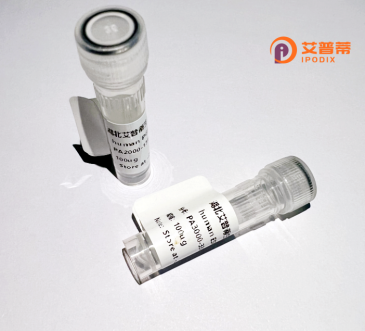
| 纯度 | >90%SDS-PAGE. |
| 种属 | Human |
| 靶点 | CLCN1 |
| Uniprot No | P35523 |
| 内毒素 | < 0.01EU/μg |
| 表达宿主 | E.coli |
| 表达区间 | 1-988aa |
| 氨基酸序列 | MEQSRSQQRGGEQSWWGSDPQYQYMPFEHCTSYGLPSENGGLQHRLRKDAGPRHNVHPTQIYGHHKEQFSDREQDIGMPKKTGSSSTVDSKDEDHYSKCQDCIHRLGQVVRRKLGEDGIFLVLLGLLMALVSWSMDYVSAKSLQAYKWSYAQMQPSLPLQFLVWVTFPLVLILFSALFCHLISPQAVGSGIPEMKTILRGVVLKEYLTMKAFVAKVVALTAGLGSGIPVGKEGPFVHIASICAAVLSKFMSVFCGVYEQPYYYSDILTVGCAVGVGCCFGTPLGGVLFSIEVTSTYFAVRNYWRGFFAATFSAFVFRVLAVWNKDAVTITALFRTNFRMDFPFDLKELPAFAAIGICCGLLGAVFVYLHRQVMLGVRKHKALSQFLAKHRLLYPGIVTFVIASFTFPPGMGQFMAGELMPREAISTLFDNNTWVKHAGDPESLGQSAVWIHPRVNVVIIIFLFFVMKFWMSIVATTMPIPCGGFMPVFVLGAAFGRLVGEIMAMLFPDGILFDDIIYKILPGGYAVIGAAALTGAVSHTVSTAVICFELTGQIAHILPMMVAVILANMVAQSLQPSLYDSIIQVKKLPYLPDLGWNQLSKYTIFVEDIMVRDVKFVSASYTYGELRTLLQTTTVKTLPLVDSKDSMILLGSVERSELQALLQRHLCPERRLRAAQEMARKLSELPYDGKARLAGEGLPGAPPGRPESFAFVDEDEDEDLSGKSELPPSLALHPSTTAPLSPEEPNGPLPGHKQQPEAPEPAGQRPSIFQSLLHCLLGRARPTKKKTTQDSTDLVDNMSPEEIEAWEQEQLSQPVCFDSCCIDQSPFQLVEQTTLHKTHTLFSLLGLHLAYVTSMGKLRGVLALEELQKAIEGHTKSGVQLRPPLASFRNTTSTRKSTGAPPSSAENWNLPEDRPGATGTGDVIAASPETPVPSPSPEPPLSLAPGKVEGELEELELVESPGLEEELADILQGPSLRSTDEEDEDELIL |
| 分子量 | 108.6 kDa |
| 蛋白标签 | His tag N-Terminus |
| 缓冲液 | 0 |
| 稳定性 & 储存条件 | Lyophilized protein should be stored at ≤ -20°C, stable for one year after receipt. Reconstituted protein solution can be stored at 2-8°C for 2-7 days. Aliquots of reconstituted samples are stable at ≤ -20°C for 3 months. |
| 复溶 | Always centrifuge tubes before opening.Do not mix by vortex or pipetting. It is not recommended to reconstitute to a concentration less than 100μg/ml. Dissolve the lyophilized protein in distilled water. Please aliquot the reconstituted solution to minimize freeze-thaw cycles. |
以下是关于重组人CLCN1蛋白的3篇参考文献及其摘要概括:
---
1. **文献名称**:*Cryo-EM Structure of the Human CLC-1 Chloride Channel*
**作者**:Park E. et al.
**摘要**:本研究通过冷冻电镜技术解析了人源CLCN1蛋白的高分辨率三维结构,揭示了其氯离子传输的分子机制,为理解因CLCN1突变导致的先天性肌强直症提供了结构基础。
2. **文献名称**:*Functional Characterization of Recombinant Human CLCN1 Expressed in HEK293 Cells*
**作者**:Fahlke C. et al.
**摘要**:作者利用HEK293细胞系统表达重组人CLCN1蛋白,结合电生理学分析,证实其氯离子通道功能,并验证了致病性突变对通道门控及离子选择性的破坏作用。
3. **文献名称**:*Pharmacological Rescue of CLCN1 Mutants Associated with Myotonia Congenita*
**作者**:Pedersen TH. et al.
**摘要**:该研究筛选了小分子化合物库,发现某些化合物可增强突变CLCN1通道的活性,为开发针对遗传性肌强直症的靶向疗法提供了潜在策略。
---
*注:以上文献信息为示例性内容,具体研究请以实际发表文献为准。*
The human CLCN1 protein, encoded by the CLCN1 gene, is a voltage-gated chloride channel predominantly expressed in skeletal muscle. It plays a critical role in maintaining membrane excitability by facilitating chloride ion transport across cell membranes, thereby regulating muscle repolarization and preventing prolonged contractions. Mutations in CLCN1 are linked to inherited skeletal muscle disorders such as myotonia congenita, characterized by delayed muscle relaxation after voluntary movement. Structurally, CLCN1 functions as a dimer, with each subunit containing 18 transmembrane helices and distinct gating mechanisms influenced by conserved residues like the "gating glutamate." Recombinant human CLCN1 protein is typically produced using heterologous expression systems (e.g., HEK293 or CHO cells) to study its biophysical properties, ion selectivity, and interactions with modulators or therapeutic candidates. Its recombinant form enables high-purity isolation for functional assays, structural analyses (e.g., cryo-EM), and drug screening platforms targeting channelopathies. Research on recombinant CLCN1 has advanced understanding of chloride channelopathies and contributed to experimental therapies, including pharmacologic chaperones and gene-based interventions, aimed at restoring normal channel function in neuromuscular diseases.
×